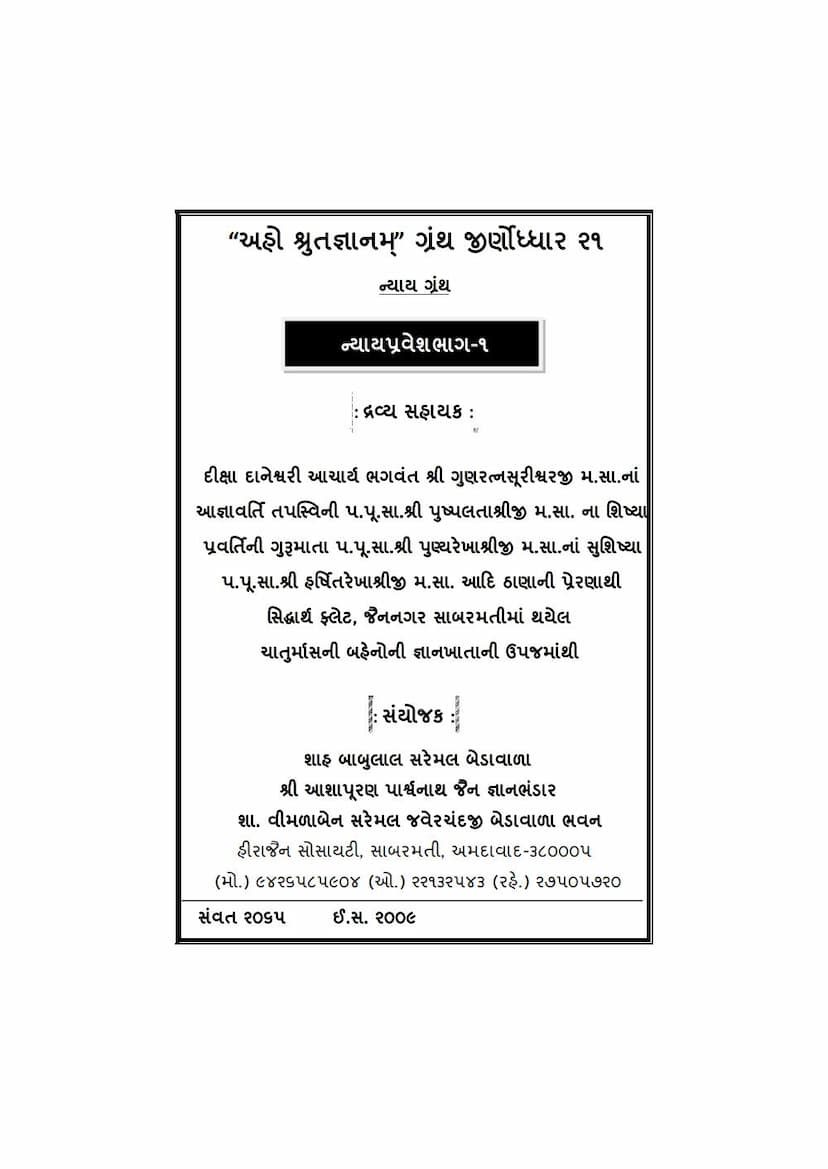Nyaya Pravesha Part 1
Added to library: September 2, 2025

Summary
This is a comprehensive summary of the provided Jain text, "Nyaya Pravesha Part 1," based on the information from the provided pages.
Book Title: Nyaya Pravesha Part 1 Author: Anandshankar B. Dhruva Publisher: Oriental Institute, Baroda Year of Publication: First Edition: 1930, Second Edition (Reprint): 1968
Overall Purpose:
The "Nyaya Pravesha Part 1" is a critical edition of a significant text on Buddhist logic, notable for its inclusion of commentaries by the famous Jain scholar Haribhadrasuri. The publication aims to make this important philosophical work accessible to scholars and students of ancient Indian philosophy, particularly those interested in Buddhist logic. The editor, Anandshankar B. Dhruva, has also provided his own English notes to enhance understanding.
Key Sections and Content:
The provided text includes several crucial sections that shed light on the content, context, and scholarly debate surrounding the "Nyaya Pravesha."
-
Preliminary Pages (Pages 1-6):
- Gujarati Title Page: Indicates the book is a "Nyaya Granth" (Logic Text) and "Nyaya Pravesha Bhag 1" (Nyaya Pravesha Part 1). It also lists the patrons and supporters of the publication, highlighting the financial assistance from the Ministry of Education, Government of India, and the support from Jain institutions and individuals.
- English Title Page: Clearly states "THE NYĀYAPRAVESA Part I Sanskrit Text with Commentaries Critically edited with Notes and Introduction by ANANDSHANKAR B. DHRUVA." It also lists the publisher as the Oriental Institute, Baroda, and the year 1968 for the second edition.
- Foreword (Page 5): By B. J. Sandesara, Director of the Oriental Institute, Baroda. It contextualizes the reprint within the Gaekwad's Oriental Series, mentioning the importance of the "Nyāyapravesa" as a text of Buddhist logic and noting its commentary by Haribhadrasuri. It also thanks the Ministry of Education for financial aid.
-
Introduction by Anandshankar B. Dhruva (Pages 7-37): This is a detailed and scholarly introduction that delves into several critical aspects:
- Authorship of the Nyaya Pravesha (Pages 7-15): Dhruva meticulously discusses the debate surrounding whether the "Nyāyapravesa" was authored by Dignāga, the renowned Buddhist logician, or his pupil Sankarasvāmin. He examines evidence from Tibetan and Chinese traditions, scholarly interpretations of various texts (like Kumārila's Ślokavārtika), and linguistic and terminological discrepancies. His personal opinion, based on the trend of evidence, tentatively attributes the work to Sankarasvāmin as an introduction to Dignāga's "Nyāyadvara."
- The Nyayapravesa and the Manimekhalai (Pages 15-18): This section explores the striking similarity between the "Nyāyapravesa" and Chapter XXIX of the Tamil epic "Manimekhalai." Dhruva analyzes the arguments for the "Manimekhalai" being based on the "Nyāyapravesa" and discusses counter-arguments suggesting the "Manimekhalai" might be earlier, highlighting specific points of doctrinal coincidence and divergence. He leans towards the hypothesis that the "Manimekhalai" borrowed from the "Nyāyapravesa."
- Dignāga and Prasastapāda (Pages 18-24): This part addresses the complex chronological relationship and intellectual indebtedness between Dignāga and Prasastapāda, a prominent Vais'eșika philosopher. Dhruva weighs arguments regarding who preceded whom, considering their respective contributions to Indian logic, the development of concepts like Vyāpti, and the style of their writings. He concludes that the balance of probability favors Prasastapāda's priority to Dignāga.
- Dignāga's Contributions to Indian Logic (Pages 24-33): Dhruva critically examines the purported original contributions of Dignāga to Indian logic, including:
- The view that a proposition is a judgment, not just terms.
- The rejection of the five-membered syllogism, reducing it to three.
- The introduction of the "three phases of Hetu" (the middle term).
- The use of universal propositions in inference.
- Miscellaneous Matters (Pages 33-37): This includes discussions on:
- The original name of the work ("Nyayapravesa").
- Commentaries on the work by various Jaina and Buddhist scholars like Haribhadra, Arcata, and S'ricandra, along with their estimated dates.
- The manuscripts used for the edition.
- Apologies for any misprints and acknowledgments.
-
References (Pages 38-40): A list of books and articles consulted, providing a rich bibliography for further research into Indian logic and philosophy.
-
Contents (Page 41): An outline of the book's structure, mirroring the sections covered in the Introduction.
-
Sanskrit Text and Commentaries (Pages 43-81):
- Nyāyapraveśaka Sūtram (Pages 43-50): The Sanskrit original text of the "Nyaya Pravesha."
- Nyāyapraveśa Vrtti by Haribhadrasuri (Pages 51-74): The commentary by the renowned Jain scholar Haribhadrasuri.
- Nyāyapraveśavrtti Panjika by Parshvadeva (Pages 81-125): A further commentary or gloss by Parshvadeva.
Key Themes and Arguments:
- The nature of knowledge and inference: The text fundamentally explores how knowledge is acquired and validated, focusing on the Buddhist logical framework.
- The role of perception (Pratyaksa) and inference (Anumana): It defines and distinguishes these two primary means of valid knowledge.
- The concept of Fallacies (Ābhāsa): A significant portion is dedicated to identifying and explaining various fallacies in thesis (pakṣābhāsa), reason (hetvābhāsa), and example (dṛṣṭāntābhāsa).
- Historical and Scholarly Debate: The introduction highlights the ongoing scholarly discussions regarding the authorship of the "Nyāyapravesa" and its relationship with other contemporary philosophical works and traditions.
- Buddhist Logic: The "Nyāyapravesa" itself is a foundational text in Dignāga's system of Buddhist logic, which significantly influenced subsequent Indian philosophical discourse.
Significance:
This publication represents a scholarly effort to preserve and disseminate a crucial text in the history of Indian logic. By critically editing the Sanskrit original and providing commentaries, it offers a valuable resource for understanding the sophisticated analytical tools developed within Buddhist and Jain philosophical traditions. The editor's introduction further contextualizes the text within broader debates in Indian philosophy, making it a landmark contribution to the field.